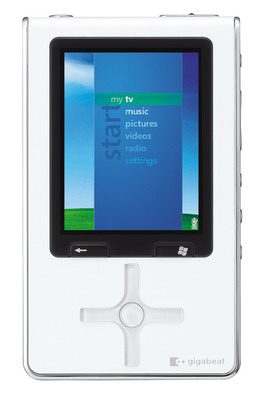PMC 2.0 Profiled: The Toshiba Gigabeat S Series Portable Media Center
July 5th, 2006 Jason Dunn

[click the image above for a high-res photo]
The Toshiba Gigabeat S is a second generation Portable Media Center device that’s the polar opposite of the LG PM70. Where the PM70 was a big-screen device aimed at delivering a great video-watching experience, the Gigabeat S is has it’s sights set right on the heart of the iPod (as in, a mostly audio-focused device), and if early reviews are any indication, it will deliver a haymaker punch. The iPod empire will not topple overnight, but if Toshiba’s Gigabeat S is any indication of what we have to look forward to, the future of PMCs is bright indeed.
At CES 2006, I had some hands-on time with a pre-production Gigabeat S, and I was quite impressed. The first thing that impressed me was the size - I had never seen Windows Mobile running on anything that small before (this was before the release of the HTC Star Trek). The 30 GB version of this device weighs a featherweight 4.8 ounces and measures 3.93 by 2.36 by 0.58 inches. It’s small. The 60 GB version is exactly the same size but weighs 5.3 ounces. Did you catch that? 60 freakin’ gigabytes! That might be old news to iPod owners, but it’s great news for PMC owners. In first generation PMCs, 20 GB was where storage topped out. The LG PM70, a video-focused unit (where storage is even more important), only comes in a 30 GB flavour. The Gigabeat S 60 GB offering is a different colour - jet black - and as you can tell, I’m excited about having 60 GB of storage. Unfortunately, that’s not quite enough space for me to carry 100% of my music collection (which stands at 67 GB) but it’s a heck of a lot better than 30 GB.
The screen resolution is still 320 x 240, but because it’s only 2.4 inches in size, the result is extremely crisp images and text. That’s 166 DPI for you hardcore geeks out there - by way of comparison, the LG PM70’s 4.3 inch screen means it’s only 93 DPI. The higher the DPI value, better everything looks. The codec support is where things fall apart a bit - it only supports MP3, WMA Lossless, WMA, and WAV files. No OGG support for you open-source types, and worse, no support for anything beyond WMV for video. That means no DivX, Xvid, or any other video files. If you’re lucky (and have the right codecs installed), Windows Media Player will transcode them for you, but it’s a very slow process. It’s a shame Toshiba didn’t broaden their horizons with enhanced codec support.
There are compromises that have to be made in order to get something this small, and battery life is where the Gigabeat S struggles slightly - but not much, because 12 hours of audio or 2.5 hours of video isn’t too shabby for a device this size. Given the size of the screen, it’s not optimized for video playback, so the 2.5 hour battery life doesn’t surprise me too much. It would have been nice to see at least 15 hours of audio playback, but 12 hours is enough if you don’t mind charging it regularly.
C|NET has a review of the Toshiba Gigabeat S if you’d like to learn more. Myself, I’m hoping to get my hands on one at some point, and will give you a full report when I do. Are you a Gigabeat S owner? I’d love to hear from you - how do you like the device so far?